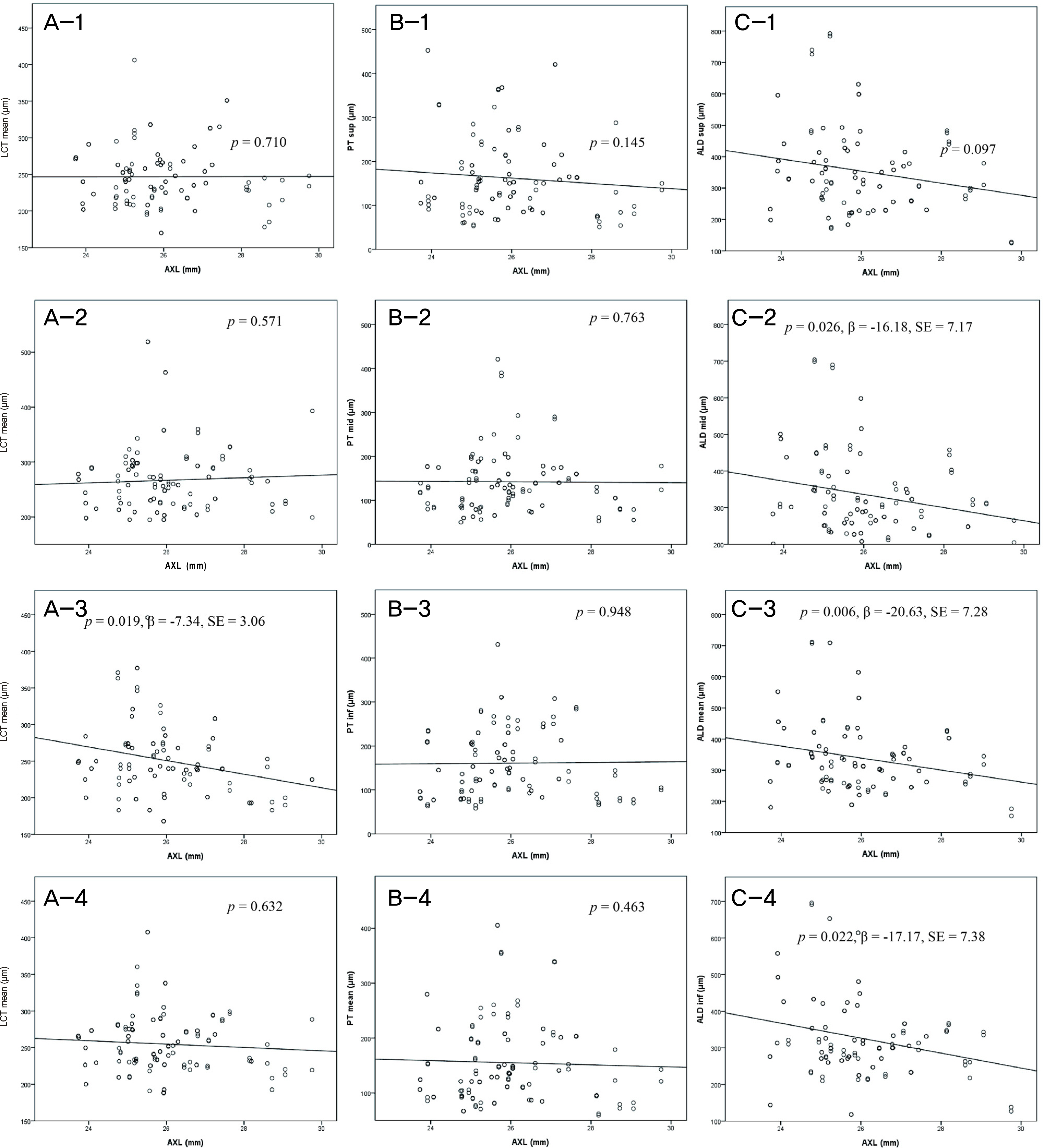J Korean Ophthalmol Soc.
2015 May;56(5):745-752. 10.3341/jkos.2015.56.5.745.
Axial Length Correlation to Lamina Cribrosa Thickness, Prelaminar Tissue Thickness, and Anterior Laminar Displacement
- Affiliations
-
- 1Department of Ophthalmology, Samsung Medical Center, Sungkyunkwan University School of Medicine, Seoul, Korea. Cdy8508@daum.net
- KMID: 2121174
- DOI: http://doi.org/10.3341/jkos.2015.56.5.745
Abstract
- PURPOSE
In this study we determined the correlation of axial length to lamina cribrosa thickness (LCT), prelaminar tissue thickness (PT), and anterior laminar displacement (ALD) in young healthy eyes.
METHODS
The optic discs of 60 eyes from 30 young healthy subjects with myopia were scanned using enhanced-depth imaging spectral-domain optical coherence tomography (Spectralis OCT, Heidelberg Engineering, Heidelberg, Germany). The LCT, PT, and ALD were measured at the superior midperipheral, middle, and inferior midperipheral of the optic nerve head, respectively. A linear mixed-effects model was used to determine the relationship between the axial length and the LCT, axial length and PT as well as axial length and ALD.
RESULTS
The mean, superior midperipheral, and middle LCT were not significantly correlated with axial length. Conversely, the inferior midperipheral LCT was negatively correlated with axial length (p = 0.019, beta = -7.34). There was no significant association between axial length and PT. Mean ALD was negatively correlated with axial length (p = 0.022, beta = -17.17).
CONCLUSIONS
In the present study, the inferior midperipheral LCT and mean ALD were negatively correlated with axial length, but PT showed no significant association with axial length.
Keyword
Figure
Reference
-
References
1. Xu L, Wang Y, Wang S, et al. High myopia and glaucoma susceptibility the Beijing Eye Study. Ophthalmology. 2007; 114:216–20.2. Kuzin AA, Varma R, Reddy HS, et al. Ocular biometry and open-angle glaucoma: the Los Angeles Latino Eye Study. Ophthalmology. 2010; 117:1713–9.
Article3. Perera SA, Wong TY, Tay WT, et al. Refractive error, axial dimensions, and primary open-angle glaucoma: the Singapore Malay Eye Study. Arch Ophthalmol. 2010; 128:900–5.4. Jonas JB, Xu L. Histological changes of high axial myopia. Eye (Lond). 2014; 28:113–7.
Article5. Wilczek M. The lamina cribrosa and its nature. Br J Ophthalmol. 1947; 31:551–65.
Article6. Quigley HA, Addicks EM, Green WR, Maumenee AE. Optic nerve damage in human glaucoma. II. The site of injury and susceptibility to damage. Arch Ophthalmol. 1981; 99:635–49.7. Radius RL, Anderson DR. Rapid axonal transport in primate optic nerve. Distribution of pressure-induced interruption. Arch Ophthalmol. 1981; 99:650–4.8. Jonas JB, Berenshtein E, Holbach L. Lamina cribrosa thickness and spatial relationships between intraocular space and cerebrospinal fluid space in highly myopic eyes. Invest Ophthalmol Vis Sci. 2004; 45:2660–5.
Article9. Ren R, Wang N, Li B, et al. Lamina cribrosa and peripapillary sclera histomorphometry in normal and advanced glaucomatous Chinese eyes with various axial length. Invest Ophthalmol Vis Sci. 2009; 50:2175–84.
Article10. Lee EJ, Kim TW, Weinreb RN, et al. Visualization of the lamina cribrosa using enhanced depth imaging spectral-domain optical coherence tomography. Am J Ophthalmol. 2011; 152:87–95.e1.
Article11. Park HY, Park CK. Diagnostic capability of lamina cribrosa thickness by enhanced depth imaging and factors affecting thickness in patients with glaucoma. Ophthalmology. 2013; 120:745–52.
Article12. Lee EJ, Kim TW, Weinreb RN, et al. Lamina cribrosa thickness is not correlated with central corneal thickness or axial length in healthy eyes: central corneal thickness, axial length, and lamina cribrosa thickness. Graefes Arch Clin Exp Ophthalmol. 2013; 251:847–54.13. Lee EJ, Kim TW, Weinreb RN, et al. Visualization of the lamina cribrosa using enhanced depth imaging spectral-domain optical coherence tomography. Am J Ophthalmol. 2011; 152:87–95.e1.
Article14. McCulloch CE, Neuhaus JM. Encyclopedia of biostatistics. 2nd ed.Chichester: John Wiley and Sons;2005.15. Reis AS, O'Leary N, Stanfield MJ, et al. Laminar displacement and prelaminar tissue thickness change after glaucoma surgery imaged with optical coherence tomography. Invest Ophthalmol Vis Sci. 2012; 53:5819–26.
Article16. Lee EJ, Kim TW, Weinreb RN, Kim H. Reversal of lamina cribrosa displacement after intraocular pressure reduction in open-angle glaucoma. Ophthalmology. 2013; 120:553–9.
Article17. Lee EJ, Kim TW, Weinreb RN. Reversal of lamina cribrosa displacement and thickness after trabeculectomy in glaucoma. Ophthalmology. 2012; 119:1359–66.
Article18. Trible JR, Sergott RC, Spaeth GL, et al. Trabeculectomy is associated with retrobulbar hemodynamic changes. A color Doppler analysis. Ophthalmology. 1994; 101:340–51.19. Minckler DS, Bunt AH. Axoplasmic transport in ocular hypotony and papilledema in the monkey. Arch Ophthalmol. 1977; 95:1430–6.
Article
- Full Text Links
- Actions
-
Cited
- CITED
-
- Close
- Share
- Similar articles
-
- Lamina Cribrosa Thickness in the Fellow Eyes of Patients with Unilateral Retinal Vein Occlusion
- Lamina Cribrosa Changes after Laser In Situ Keratomileusis in Myopic Eyes
- Measurement of Deep Optic Nerve Complex Structures with Two Spectral Domain Optical Coherence Tomography Instruments
- Comparison of the Thickness of the Lamina Cribrosa and Vascular Factors in Early Normal-tension Glaucoma with Low and High Intraocular Pressures
- Relationship between the Lamina Cribrosa, Outer Retina, and Choroidal Thickness as Assessed Using Spectral Domain Optical Coherence Tomography



